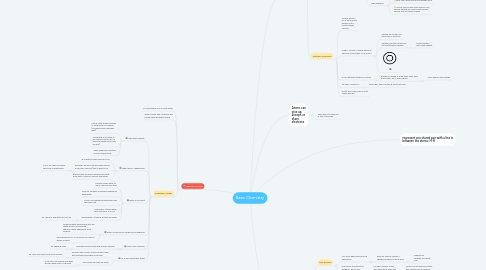
1. Chemistry of Water
1.1. All living things are 70-90% water
1.2. Water is polar and molecules are bonded with hydrogen bonds
1.3. Properties of Water
1.3.1. High heat capacity
1.3.1.1. calorie: heat energy needed to raise temp one degree (covalent bonds need half that)
1.3.1.2. converting 1g of water to ice requires loss of 80 cal (because water holds onto its heat)
1.3.1.3. Helps organisms maintain normal internal temp
1.3.2. High Heat of Vaporization
1.3.2.1. 1g of water to gas needs 540 cal
1.3.2.2. hydrogen bonds must be broken before molecules vaporize (that is hard to do
1.3.2.2.1. If not, our rivers and lakes would be all evaporated
1.3.2.3. Efficient way to release excess body heat: body heat is used to vaporize the sweat
1.3.3. Water is a solvent
1.3.3.1. polarity allows water to aid in chemical reactions
1.3.3.2. solution: contains a dissolved substance think water
1.3.3.3. solute: the substance being dissolved think kool-aid
1.3.3.4. Hydrophilic: attract water, allow reactions to occur
1.3.3.5. Hydrophobic: nonpolar, doesnt like water
1.3.3.5.1. Ex: Gasoline and water do not mix
1.3.4. Water molecules are cohesive and adhesive
1.3.4.1. cohesive-water flows freely into any shape but do not seperate adhesive-water adheres to polar surfaces
1.3.4.2. Good transport Ex: in our blood OR roots to leaves in plants
1.3.5. High surface tension
1.3.5.1. Hydrogen bonds cause high surface tension
1.3.5.1.1. Ex: skipping rocks
1.3.6. Ice is less dense than water
1.3.6.1. as water gets colder, molecules get closer but hydrogen bonds get more open
1.3.6.1.1. Ex: why soda cans burst in the freezer
1.3.6.2. This is why ice floats on water
1.3.6.2.1. If ice sunk, our oceans and lakes would freeze solid= no habitat
2. Atoms can give up, accept, or share electrons
2.1. Their goal is to have 8 e- in their outer shell
3. represent one shared pair with a line in between the atoms: H-H
4. Chemical Elements
4.1. Basics
4.1.1. Matter: anything that takes up space and has mass
4.1.1.1. can be solid, liquid, or, gas
4.1.2. Elements: cannot be broken down, in their simplest form
4.1.2.1. judged on density, solubility, melting point, and reactivity
4.1.3. Subatomic particles are protons, neutrons, and electrons
4.1.3.1. protons & neutrons in nucleus electrons surrounding nucleus
4.1.3.1.1. electron shell=average location of electrons
4.1.3.2. atomic mass= mass number= protons and neutrons
4.1.3.2.1. Atoms: The smallest make-up of an element
4.2. Periodic Table
4.2.1. Ordered by ascending atomic #
4.2.1.1. atomic # = number of protons
4.2.2. vertical columns=groups horizontal rows=periods
4.2.3. neutrons= atomic mass-protons
4.3. Isotopes
4.3.1. Different form of an element
4.3.1.1. same element, same protons different neutrons, different mass
4.3.1.2. EX: Carbon12, Carbon13, Carbon14
4.3.2. Isotopes can decay/release energy and become radioactive
4.3.2.1. Low Radiation
4.3.2.1.1. in small amounts
4.3.2.1.2. can be used as a tracer
4.3.2.2. High Radiation
4.3.2.2.1. in large amounts
4.3.2.2.2. BAD: can cause cancer and damage DNA
4.3.2.2.3. GOOD: can be used to kill cancer cells, sterilize dentist and doctor instruments, sterilize mail of deadly anthrax
4.4. Electrons and Energy
4.4.1. Neutral Atoms= p+ in the nucleus balance out e- moving about nucleus
4.4.2. Orbital: volume of space where an electron is most likely to be found
4.4.2.1. Orbitals will contain no more than 2 electrons
4.4.2.2. Orbitals near the nucleus are circular/dumbbell shaped
4.4.2.2.1. Distant orbitals have other shapes
4.4.2.3. .
4.4.3. e- are attracted to the p+ nucleus
4.4.3.1. Energy is needed to push them away from each other, aka in their orbitals
4.4.3.1.1. more space=more energy
4.4.4. 1st shell: 2 electrons
4.4.4.1. After that, shells contain 8 electrons each
4.4.5. Octet Rule: outer shell is most stable with 8 e-
5. Elements and Compounds
5.1. Ionic Bonding
5.1.1. Ions form when electrons are transferred
5.1.1.1. electron transfer causes a charge imbalance in each atom
5.1.1.1.1. imbalanced particles are called ions
5.1.2. ionic bond: the attraction between - and + ions
5.1.2.1. ex: when sodium reacts with chlorine to make salt
5.1.2.1.1. When salts are placed in water, they release ions to dissolve
5.2. compound: when atoms of two or more diff elements bond together
5.3. molecule: smallest part of a compound still containing its properties
5.4. Covalent Bonding
5.4.1. covalent bond: when atoms share electrons -to complete their octet
5.4.1.1. representing a double covalent bond: O=O
5.4.1.2. triple bonds are the strongest: represent with three lines
5.5. Shapes of Molecuels
5.5.1. Molecules have 3D shape
5.5.2. Different shapes for amount of atoms
5.5.2.1. 2atom-linear 5atom-tetrahedral
5.5.3. Hormones have specific shape to be recognized
5.5.4. antibodies and disease causing agents act like a lock and key fit
5.6. Non-polar vs. Polar Covalent
5.6.1. Nonpolar: when the sharing of electrons between 2 atoms is about equal
5.6.2. electronegativity: the attraction of an atom for the electrons in a covalent bond
5.6.2.1. more protons=more elecronegative
5.6.3. Polar Covalent bonds; the unequal sharing of electrons
5.6.3.1. Ex: water because the molecule itself is polar
5.7. Hydrogen Bonding
5.7.1. hydrogen bond: when polarity from H2O is attracted to hydrogen atoms
5.7.1.1. weakest type of bond-easily broken
5.7.1.2. represented with a dotted line
5.7.2. hydrogen bonds are what hold the 2 strands of DNA together

